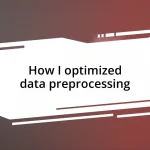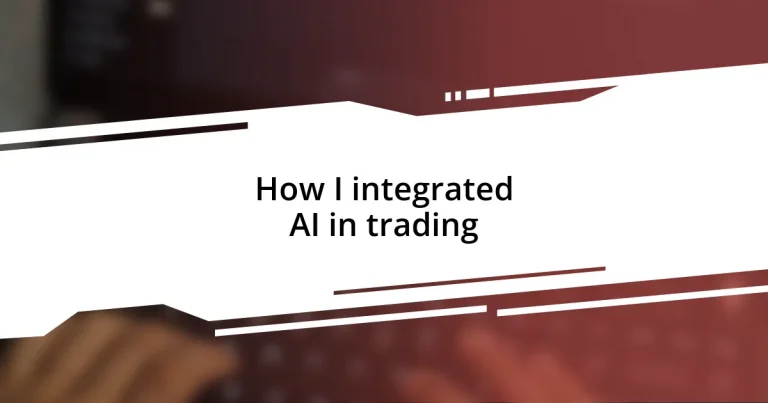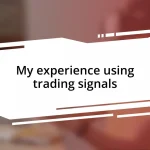Key takeaways:
- AI can analyze vast data quickly, complementing human intuition and experience in trading.
- Choosing AI tools requires careful consideration of performance history, customization, support, cost, and integration.
- Effective trading strategies involve clear goal-setting, risk management, and thorough backtesting with historical data.
- Ongoing monitoring and adaptability to market changes enhance AI trading performance and decision-making.
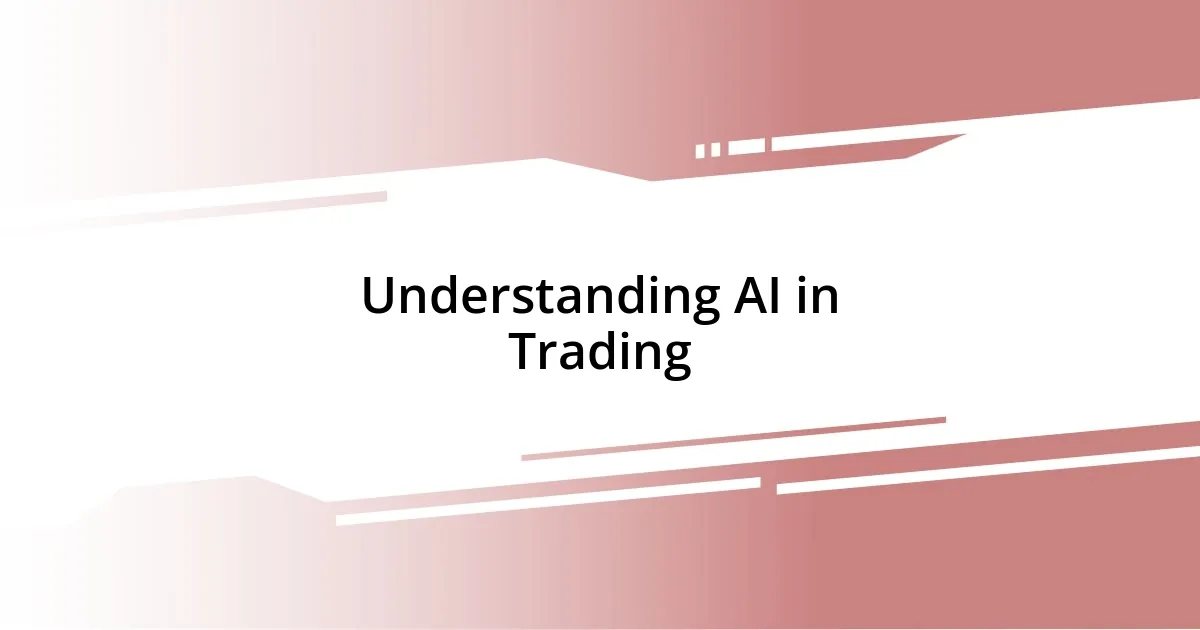
Understanding AI in Trading
Understanding AI in trading can feel like stepping into a new world. I remember when I first started exploring this technology; it was both exciting and overwhelming. The idea that algorithms could analyze vast amounts of data and predict market trends was almost magical. However, what really struck me was the sheer speed at which AI can process information—something that would take a human hours or even days just takes seconds for a good AI model.
The emotional weight of relying on AI can be significant. There’s that nagging fear: are you putting your financial future in the hands of a machine? I faced this dilemma when I allowed an AI-driven system to handle a portion of my trades. Watching the numbers fluctuate was nerve-wracking, but with time, I recognized that, despite my initial trepidation, AI was designed to complement human intuition and experience, not replace it.
It’s fascinating how AI uses machine learning to adapt and improve over time. For instance, I once watched an algorithm adjust its trading strategies after observing a shift in market sentiment during a financial crisis. It was like watching a child learn to ride a bike—wobbling at first, but quickly gaining speed and stability. Do you ever wonder how much faster we could learn if we harnessed the true potential of AI in our trading strategies?
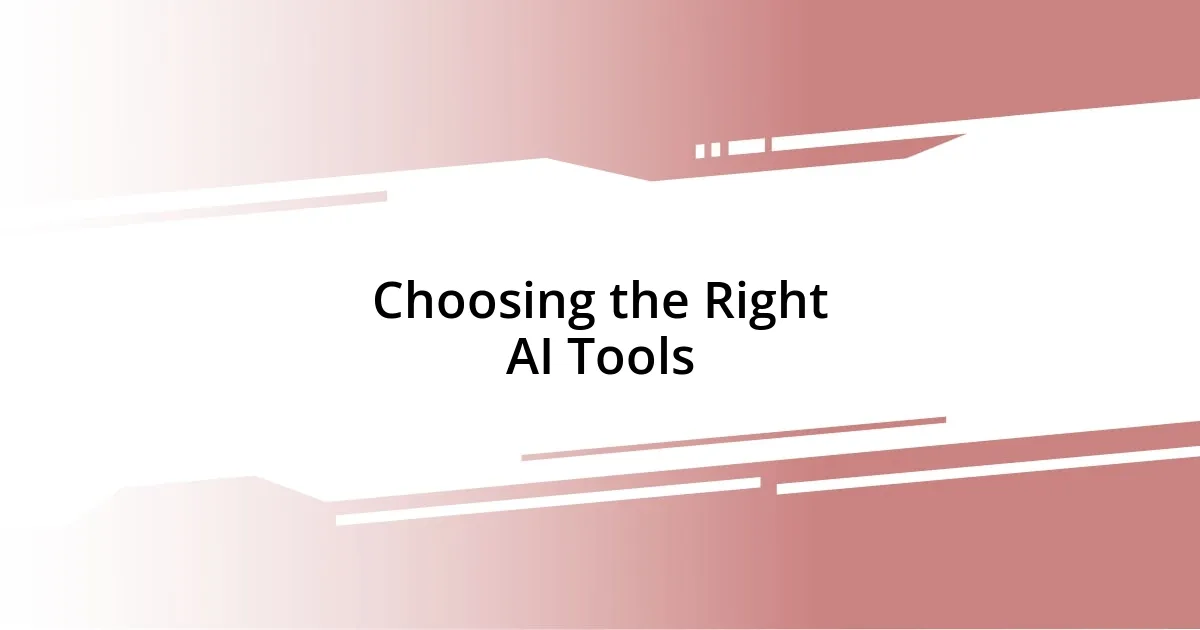
Choosing the Right AI Tools
Choosing the right AI tools for trading can be daunting. I recall an experience where I spent weeks researching various platforms. Each tool promised the moon and stars, but I soon learned that not all AI solutions are made equal. It’s vital to consider factors such as data quality, user interface, and scalability. Tools that are intuitive can save you hours of frustration, allowing you to focus on refining your trading strategies.
When it comes down to making a choice, here are a few essential criteria to consider:
- Performance History: Look for tools with proven track records in different market conditions.
- Customization Options: I appreciate tools that let me adjust parameters to fit my trading style.
- Support and Community: Engage with platforms that offer robust support and an active user community for shared insights.
- Cost-effectiveness: Assess whether the potential gains justify the costs; some tools can be pricey with minimal return.
- Integration Capabilities: I prefer tools that can integrate easily with other software I use, streamlining my workflow.
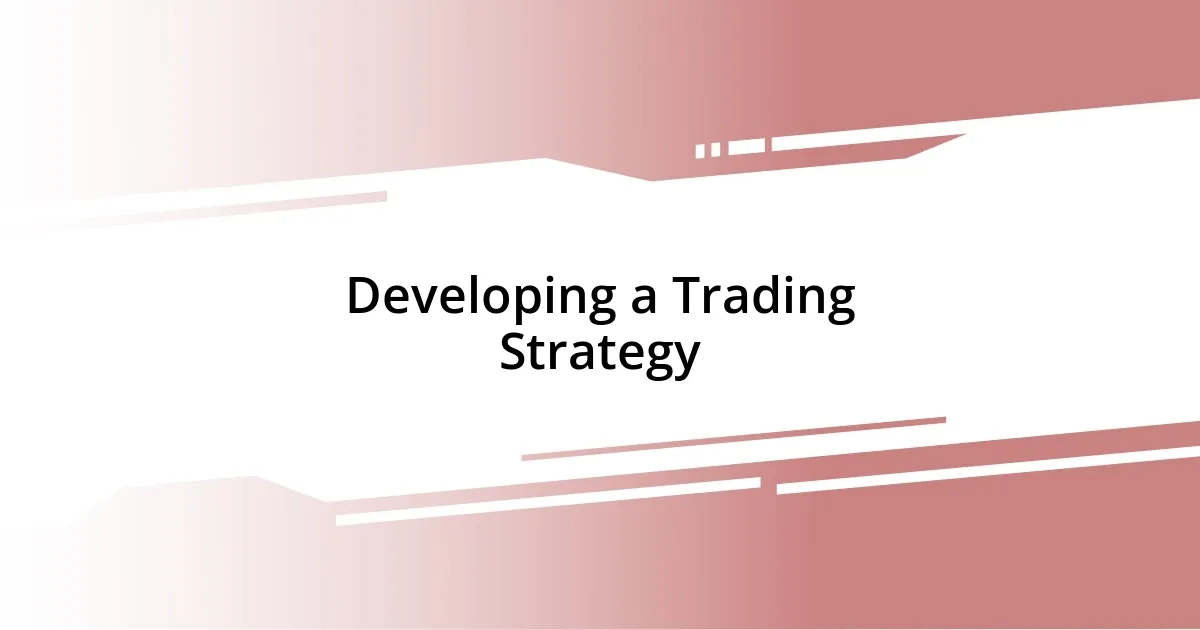
Developing a Trading Strategy
When developing a trading strategy, I believe that clarity of goals is crucial. Setting your objectives upfront can streamline your decision-making process later. Personally, I always ask myself what I want to achieve: am I looking for short-term gains or long-term investment growth? This distinction helps me stay focused and avoid getting sidetracked by market noise.
Another aspect that I find vital in forming a strategy is risk management. I’ve learned from experience that even the best trading strategies will encounter losses. I recall a time when I ignored stop-loss orders, thinking I could outsmart the market, only to see my investments plummet. It taught me the importance of predefined risk levels and the need to stick to them. Always remember: it’s not just about winning but also about minimizing losses.
Lastly, backtesting strategies against historical data is a step I never skip. It feels like getting a sneak peek into potential outcomes. I remember how reassuring it was to see my strategy perform well over past market fluctuations; it made me more confident in executing live trades. However, it’s essential to keep in mind that past performance doesn’t guarantee future success—always approach new trades with an open mind.
| Aspect | Considerations |
|---|---|
| Goals | Define short-term vs. long-term objectives |
| Risk Management | Predefine risk levels; use stop-loss orders |
| Backtesting | Test strategies on historical data for assurance |
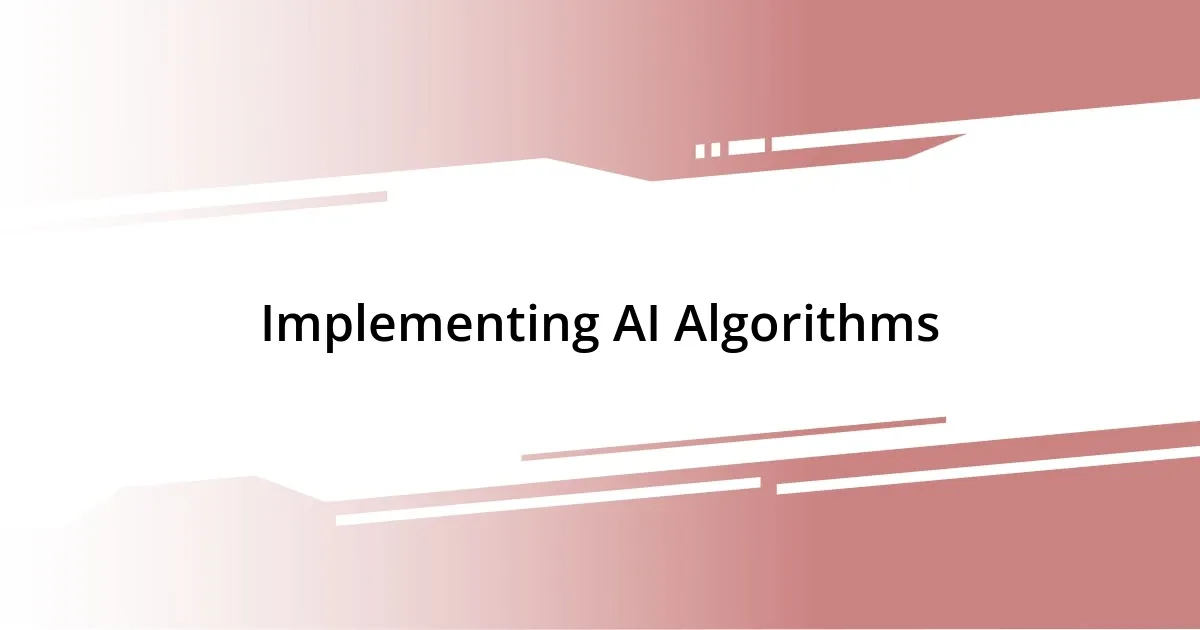
Implementing AI Algorithms
Implementing AI algorithms in trading can be a game-changer, but it’s also where many get lost in the complexities. When I first implemented my algorithms, I felt the butterflies of excitement and anxiety. The thrill of watching my AI analyze vast amounts of market data was invigorating, but I quickly realized that fine-tuning the algorithms was crucial for success. I had to ask myself, “How can I ensure that my AI is not just spitting out random conclusions?” This led me to meticulously adjust the parameters to align them with my trading goals.
One of the key moments for me was when I dared to let the AI take charge on a simulated trading platform. I distinctly remember the waves of uncertainty rushing over me as I hit ‘start’. To my surprise, the AI identified trading opportunities I hadn’t even considered, and that feeling was both exhilarating and a little humbling. Watching the algorithm execute trades felt like peering into the future, revealing insights that manual analysis might miss.
I couldn’t ignore the importance of choosing the right learning model. Early on, I experimented with both supervised and unsupervised learning algorithms. Each had its benefits, but I found that supervised learning offered more control and predictability in fluctuating markets. Have you ever experienced that moment when you realize an adjustment can significantly impact your results? That’s exactly how I felt when I refined my algorithm to better capture market trends, transforming my initial doubts into a confident trading strategy.
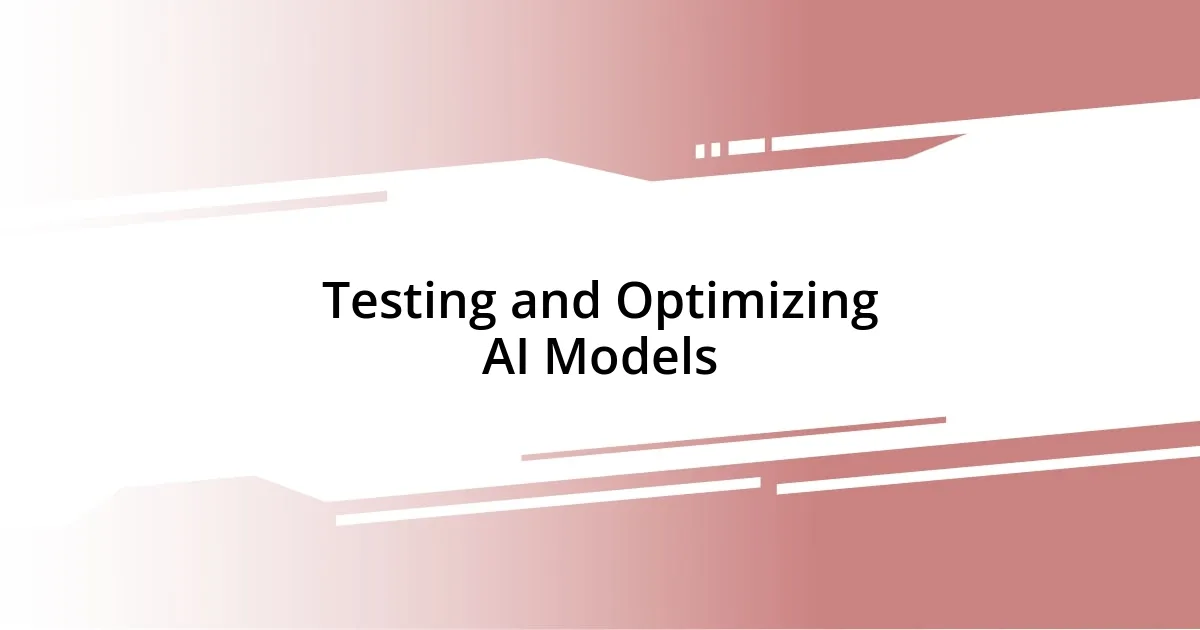
Testing and Optimizing AI Models
Testing the AI models I implemented became a pivotal part of my trading journey. I remember the first time I ran a series of tests on a particular model: the anticipation coursed through my veins. Did I truly understand how my AI would perform under various market conditions? As I watched the model’s outputs, I learned that even the smallest tweaks could yield dramatic improvements. For instance, adjusting a few input features led to a noticeable increase in accuracy, proving to me that every detail matters.
Optimizing my models was an ongoing process, filled with trial and error. There were days when I felt like I was wrestling with the AI rather than working alongside it. One afternoon, after a string of disappointing results, I decided to dive deep into hyperparameter tuning. I asked myself, “What adjustments can I make to enhance performance?” Each experiment revealed insights into the model’s behavior. I found joy in capturing the subtle nuances of the data, which led to not just better predictions but a newfound confidence in my AI’s capabilities.
Utilizing validation techniques later reinforced my understanding of the models I was deploying. I conducted k-fold validation, where I split the data into subsets to ensure my model wasn’t just memorizing the dataset. The first time I saw improved results during the validation phase, I felt a sense of relief. It was a reminder that robust testing doesn’t just elevate the model; it enriches my trading decisions, translating AI’s potential into real-world value. Have you ever experienced that moment of clarity when everything clicks into place? That’s the feeling I strive for with each optimization.
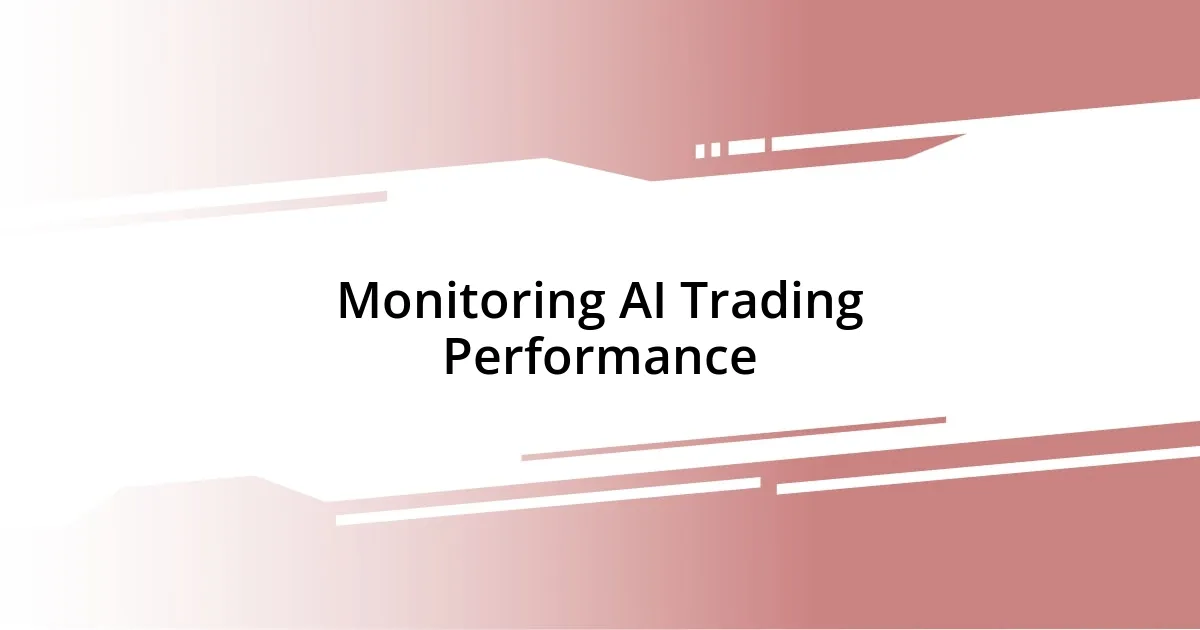
Monitoring AI Trading Performance
Monitoring AI trading performance is a critical step that I’ll never overlook. I vividly recall sitting in front of my screen, grappling with the performance metrics for the first time. It was a mix of curiosity and nervousness—was I interpreting the data correctly? By closely tracking key performance indicators like Sharpe ratio and drawdown, I learned to paint a clearer picture of my AI’s effectiveness, guiding my decisions on future adjustments.
After I established a routine for monitoring performance, I realized it wasn’t as dry as it sounded. In fact, each day transformed into a learning experience. I remember a moment where the AI recorded an unexpected drop in performance. Instead of panicking, that setback sparked a deeper analysis. I thought to myself, “What does this tell me about market shifts?” This reflection opened up discussions about adaptability, showing me that monitoring isn’t merely numbers on a screen—it’s a dialogue with the market itself.
Trust me when I say that real-time monitoring truly amplified my trading strategy. I fondly recall integrating alerts that notified me about significant performance changes. One evening, I got an alert about an unusually high volatility, and it saved me from potential losses. This experience solidified my belief that active monitoring acts like a safety net, allowing me to stay agile. How do you approach your monitoring process? For me, turning data into actionable insights has been pivotal in the ever-evolving landscape of AI trading.
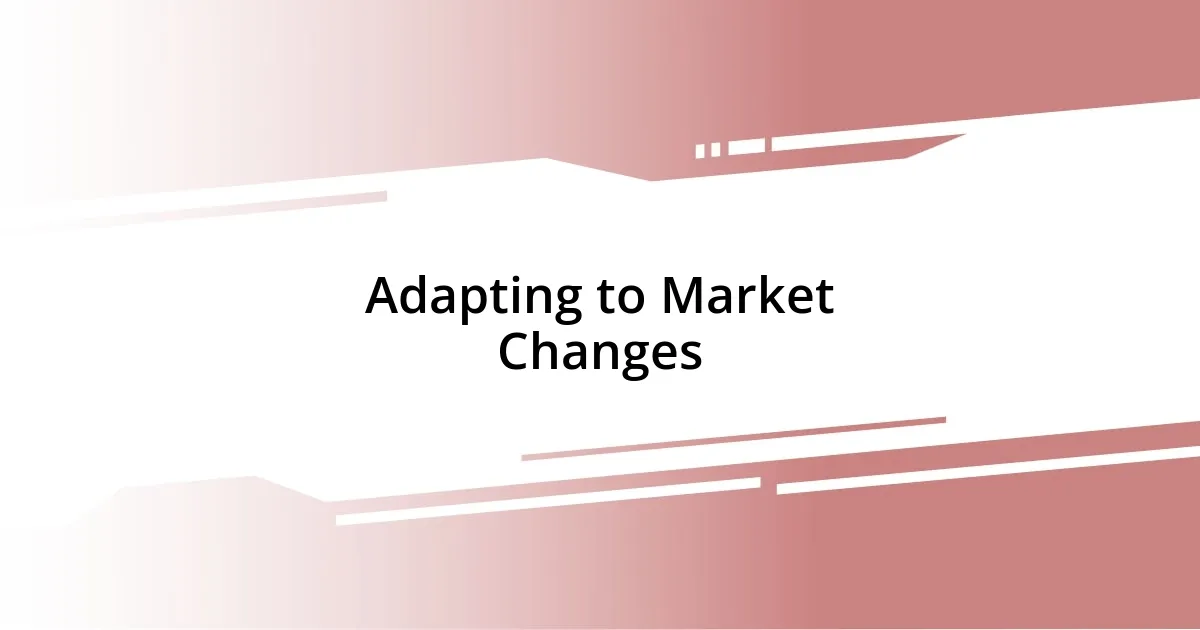
Adapting to Market Changes
Adapting to market changes is essential in trading, especially when working with AI. There was a time when I misjudged a shift in market sentiment. I had become so comfortable with the AI’s predictions that I neglected to account for external factors like news events and economic shifts. That day, when my AI’s model generated a surprising sell signal, I hesitated, recalling lessons about the unpredictable nature of markets. In the end, I relied on my experience and intuition, and it taught me to remain flexible even when technology leads the way.
As I adapted to these changes, I adopted a more proactive stance. I remember incorporating real-time news sentiment analysis into my strategy. It was thrilling to witness how quickly the AI could process information and highlight potential trading opportunities. One particular instance stands out: I received breaking news about a market disruption, and the AI immediately adjusted its parameters. Watching this unfold left me in awe, reaffirming that a successful strategy blends human insight with machine learning.
I’ve come to understand that adaptation isn’t just a function of technology; it’s also about mindset. Each market shift compels me to reevaluate my strategies. I often ask myself, “Am I prepared to pivot?” This question drives me to refine my models consistently. It’s a reminder that, while AI is a powerful tool, staying in tune with market rhythms and my own trading instincts creates a solid foundation for resilience. What strategies have you employed to adapt to changing markets? For me, adaptability has become a game-changer in my trading journey.











